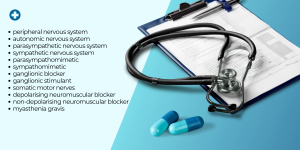Week 1: ANS Drugs
Learning Outcomes
Be able to:
- outline the steps in the processes of cholinergic transmission, including synthesis, release, postsynaptic effects, and breakdown of ACh
- discuss the different subtypes of ACh receptors, outline their signal transduction pathways, and give examples of their physiological roles
- describe the different ways by which drugs and toxins can interfere in cholinergic transmission, giving examples and therapeutic uses
- describe the steps in the processes of noradrenergic transmission, including synthesis, release, postsynaptic effects, and breakdown of NE
- discuss the different subtypes of adrenoceptors, outline their signal transduction pathways and give examples of their physiological roles
- illustrate the various ways drugs can interfere in NE transmission, giving examples & uses
- describe the mechanism of action of ganglionic blockers
- differentiate between the mechanisms of action of depolarising and non-depolarising neuromuscular blockers, and outline the therapeutic role(s) of these drugs
- outline the pathophysiology of myasthenia gravis and the mechanism of action of drugs used to treat this disorder.
Learning Overview
The Medical Pharmacology (MP) module begins with a focus on the peripheral nervous system. The PNS represents both a direct and an incidental target of many therapeutic drugs, and the understanding of these actions provides a solid platform for further weeks of MP. In this week we will examine in detail the implications and ramifications of using drugs that act on targets involved in neurotransmission in the somatic and autonomic nervous systems.
Key Topics

